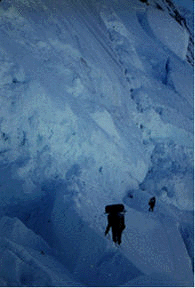Cornices are an interesting snow
feature which can often be found in snow territory. Although their
impact is often not a great as an avalanche, they can be just as deadly if
they are not approached correctly.
Windblown snow often forms cornices on ridge crests and the sides of gullies. The snow builds out horizontally, and when they break off it may be much farther back then their overhanging edge. The diagram below shows how the wind can form a wave shaped cornice. When cornices break off they might cause large slides, especially when they hit the snow pillow (see diagram) below. Along with causing large slides, they can obviously be deadly if they fall directly on a person.
Windblown snow often forms cornices on ridge crests and the sides of gullies. The snow builds out horizontally, and when they break off it may be much farther back then their overhanging edge. The diagram below shows how the wind can form a wave shaped cornice. When cornices break off they might cause large slides, especially when they hit the snow pillow (see diagram) below. Along with causing large slides, they can obviously be deadly if they fall directly on a person.

Snow Sense
Ice avalanches are a hazard that
exists in glacial areas. They are caused by the collapse of unstable
ice blocks from a steep or overhanging part of a glacier. Due to the
fact that they are part of a glacier, ice avalanches can have large amounts
of rock in them. Ice avalanches are quite dangerous because they can
travel long distances and they are usually unpredictable.
There is no specific time of day or season in which ice avalanches occur. If an ice avalanche occurs near the ocean, it can cause surge waves or tsunamis. When traveling in areas with an ice avalanche risk, move as quickly as possible to minimize exposure time. The picture below is an example of an ice avalanche.
There is no specific time of day or season in which ice avalanches occur. If an ice avalanche occurs near the ocean, it can cause surge waves or tsunamis. When traveling in areas with an ice avalanche risk, move as quickly as possible to minimize exposure time. The picture below is an example of an ice avalanche.
